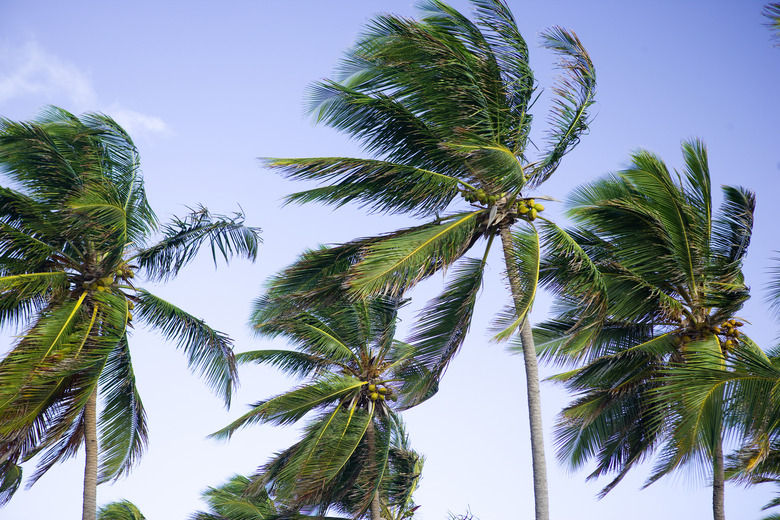How To Classify Wind Speeds
Wind, one of the fundamental characteristics of Earth's atmosphere, is the horizontal movement of air along pressure gradients. Wind can manifest as a soothing, caressing breeze or a raging, lethal typhoon. For thousands of years, human beings – particularly those taking to the open ocean or residing in areas prone to severe storms – have scrutinized the behavior of winds. Today's meteorologists use a variety of standardized scales to rate wind categories.
The Beaufort Scale
The Beaufort Scale
A widely used and formalized metric for basic wind speed is the Beaufort scale, named for Francis Beaufort, an admiral of the British navy. This reference matches estimated wind velocities with observable phenomena such as tossed canopies and ocean whitecaps. While Beaufort established his scale in the early 1800s, it owes much to older conventions and has evolved through time to be used not only at sea – as Beaufort established it – but also on land.
The Beaufort scale uses 13 wind categories, from zero to 12, according to MetOffice. These codes match to descriptive labels, which vary slightly between sources.
In order of increasing wind speed from less than one kilometer per hour to more than 120 kph (75 mph), these codes are: (0) "calm"; (1) "light air"; (2) "light breeze"; (3) "gentle breeze"; (4) "moderate breeze"; (5) "fresh breeze"; (6) "strong breeze"; (7) "moderate gale" or "near gale"; (8) "fresh gale" or "gale"; (9) "strong gale" or "severe gale"; (10) "whole gale" or "storm"; (11) "storm" or "violent storm"; and (12) "hurricane."
Reflecting its original use by mariners, the Beaufort scale categories also correspond to wave heights: from zero to 14 meters (45 feet) or higher.
Visual Wind Observations
Visual Wind Observations
The Beaufort scale is a useful one because it additionally includes descriptions of standardized observable phenomena that hint at a corresponding wind speed category. For example, under "calm" conditions, a plume of smoke rises straight up and tree foliage is still. Under a "strong breeze," big tree branches are moving, telephone wires are whistling and heavy waves are forming on water bodies. A "whole gale" uproots trees, deals significant structural damage and whips up tall waves with curling crests.
Classifying Storm Winds
Classifying Storm Winds
Meteorologists use other wind speed classifications to gauge the development of the world's severest storms, hurricanes and tornadoes. The Enhanced Fujita scale, used in North America and named for the leading severe storm expert T. Theodore Fujita, rates the strength of tornadoes in six categories, EF0 to EF5, by estimating wind speed from observable damage. The top speed of a tornado – more violent than any other storm – is unknown due to the difficulty of successfully employing weather instruments in unpredictable and destructive twisters; the EF5 scale suggests winds in excess of 322 kph (200 mph).
A similar metric, the Saffir-Simpson hurricane wind scale, rates tropical cyclones and is used to forecast property damage from a storm, notes the National Weather Service. A Category 1 hurricane howls at 119 to 153 kph (74-95 mph), while a Category 5 monster has sustained winds of 252 kph (157 mph) or greater.
Why Measure Wind
Why Measure Wind
It is important to assign wind categories to storms not only for the protection of property but also for the protection of life. When severe storms are expected, residents of the areas that will be affected need to take precautions to stay safe from the potentially dangerous conditions that strong winds can bring, like flooding and damaged power transmission lines.
Additionally, measuring wind speeds is essential for siting windmills, which harvest the energy of the wind to produce electricity. Windmill companies look for places that are isolated from residential areas that receive strong and sustained winds for wind power stations, also known as wind farms.
Cite This Article
MLA
Shaw, Ethan. "How To Classify Wind Speeds" sciencing.com, https://www.sciencing.com/classify-wind-speeds-23181/. 30 September 2021.
APA
Shaw, Ethan. (2021, September 30). How To Classify Wind Speeds. sciencing.com. Retrieved from https://www.sciencing.com/classify-wind-speeds-23181/
Chicago
Shaw, Ethan. How To Classify Wind Speeds last modified March 24, 2022. https://www.sciencing.com/classify-wind-speeds-23181/
